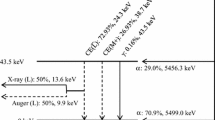Abstract
Effect factors of the absorption of the source, air, entrance window, and dead layer of a detector must be considered in the measurement of monoenergetic alpha particles, along with statistical noise and other factors that collectively cause the alpha spectrum to exhibit a well-known low-energy tail. Therefore, the establishment of an alpha spectrum detector response function from the perspective of a signaling system must consider the various factors mentioned above. The detector response function is the convolution of an alpha-particle pulse function, two exponential functions, and a Gaussian function, followed by calculation of the parameters of the detector response function using the weighted least-squares fitting method as proposed in this paper. In our experiment, 239Pu alpha spectra were measured by a high-resolution, passivated implanted planar silicon (PIPS) detector at 10 levels of vacuum and 10 source-detector distances. The spectrum-fitting results were excellent as evaluated by reduced Chi-square (χ 2) and correlation coefficients. Finally, the variation of parameters with vacuum level and source-detector distance was studied. Results demonstrate that σ, τ1, and τ2 exhibit no obvious trend of variation with vacuum in the range 2000–20,000 mTorr, and at a confidence level of 95%, the values of τ1 and τ2 decline in a similar fashion with source-detector distance by the power exponential function, while the value of σ declines linearly.






Similar content being viewed by others
References
E. García-Toraño, M.L. Aceña, G. Bortels et al., Alpha-particle emission probabilities in the decay of 239Pu. Nucl. Instrum. Methods Phys. Res. A 334, 477–484 (1993). doi:10.1016/0168-9002(93)90811-U
X. Kang, D.T. Xiao, J.L. Li, Optimization of alpha energy spectrum method for measuring radon and thoron daughters in air. Nucl. Tech. 31, 925–930 (2008). (in Chinese)
P.B. Rodríguez, A.M. Sáchez, F.V. Tomé, Experimental studies of self-absorption and backscattering in alpha-particle sources. Appl. Radiat. Isot. 48, 1215–1220 (1997). doi:10.1016/S0969-8043(97)00174-7
R.C. Noya, E. Garcia-Torano, E. Mainegracm et al., The WinALPHA code for the analysis of alpha-particle spectrum. Nucl. Instrum. Methods Phys. Res. A 525, 522–528 (2004). doi:10.1016/j.nima.2004.02.010
E. Garcia-Toraño, M.L. Aceña, Nolin: nonlinear analysis of complex alpha spectrum. Nucl. Instrum. Methods Phys. Res. A 185, 261–269 (1981). doi:10.1016/0029-554X(81)91220-9
G. Bortels, P. Collaers, Analytical function for fitting peaks in alpha-particle spectrum from Si detectors. Appl. Radiat. Isot. 38, 831–837 (1987)
A. Martín Sánchez, F. Vera Tomé, P. Rubio Montero, Fitting of alpha spectrum application to low-level measurements. Appl. Radiat. Isot. 47, 899–903 (1996)
A. Martín Sánchez, P.R. Montero, FITBOR a new program for the analysis of complex alpha spectrum. Nucl. Instrum. Methods Phys. Res. A 369, 593–596 (1996). doi:10.1016/S0168-9002(96)80058-1
A. Martín Sánchez, P. Rubio Montero, Simplifying data fitting using branching ratios as constraints in alpha spectrometry. Nucl. Instrum. Methods Phys. Res. A 420, 481–488 (1999). doi:10.1016/S0168-9002(98)01179-6
A. Baeza, J. Miranda, J. Guillén et al., A new approach to the analysis of alpha spectrum based on neural network techniques. Nucl. Instrum. Methods Phys. Res. A 652, 450–453 (2011). doi:10.1016/j.nima.2011.01.170
C.J. Bland, J. Truffy, Deconvolution of alpha-particle spectrum to obtain Plutonium Isotopic Ratios. Appl. Radiat. Isot. 43, 201–209 (1992)
S. Pommé, B. Caro Marroyo, Improved peak shape fitting in alpha spectra. Appl. Radiat. Isot. 2015(96), 148–153 (2015). doi:10.1016/j.apradiso.2014.11.023
W. Wätzig, W. Westmeier, Alfun-A program for the evaluation of complex alpha-spectrum. Nucl. Instrum. Methods 153, 517–524 (1978). doi:10.1016/0029-554X(78)91001-7
E. Steinbauer, G. Bortels, P. Bauer et al., A survey of the physical processes which determine the response function of silicon detectors to alpha particles. Nucl. Instrum. Methods Phys. Res. A 339, 102–108 (1994). doi:10.1016/0168-9002(94)91787-6
Z.H. Wu, G.Q. Zhao, F.Q. Lu et al., Nuclear Physics Experiment Method (Atomic Energy Press, Beijing, 1997), pp. 1–16. (in Chinese)
He Xiaoqun, Liu Wenqing et al., Applied Regression Analysis (China Renmin University Press, Beijing, 2011), pp. 95–100. (in Chinese)
NIST/SEMATECH e-Handbook of Statistical Methods. http://www.itl.nist.gov/div898/handbook/
Z. Li, X.G. Tuo, R. Shi et al., Analytic fitting and simulation methods for characteristic X-ray peaks from Si-PIN detector. Nucl. Sci. Tech. 24, 060206-1–060206-7 (2013)
Z. Li, X.G. Tuo, R. Shi et al., A statistical approach to fit Gaussian part of full-energy peaks from Si (PIN) and SDD X-ray spectrometers. Sci. China Technol. Sc. 57, 19–24 (2014). doi:10.1007/s11431-013-5427-7
A. Martín Sánchez, D. Caceres Marzal, Experimental study of the curve-shape variations in alpha-particle spectrometry. Nucl. Instrum. Methods Phys. Res. A 414, 265–273 (1998). doi:10.1016/S0168-9002(98)00663-9
Author information
Authors and Affiliations
Corresponding author
Additional information
This work was supported by the National Natural Science Foundation of China (Nos. 41374130 and 41604154), Opening Foundation of Sichuan Provincial Key Lab of Applied Nuclear Techniques in Geosciences (No. gnzds2014003), and the Open Fund of Robot Technology Used for Special Environment Key Laboratory of Sichuan Province (13zxtk04).
Rights and permissions
About this article
Cite this article
Shi, R., Tuo, XG., Li, HL. et al. 239Pu alpha spectrum analysis based on PIPS detector response function and variations with vacuum and distance. NUCL SCI TECH 28, 4 (2017). https://doi.org/10.1007/s41365-016-0163-x
Received:
Revised:
Accepted:
Published:
DOI: https://doi.org/10.1007/s41365-016-0163-x




